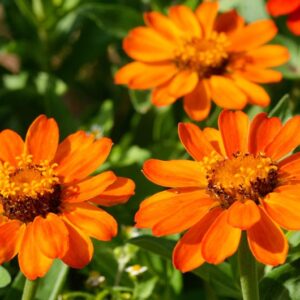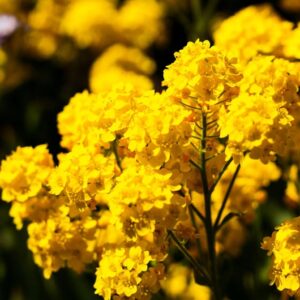
From the vibrant Uzbekistan Iris to the unique Umbrella Papyrus, the plant world offers an extraordinary array of ‘flowers that start with U’. These unsung heroes of the botanical kingdom offer an array of shapes, colors, and growing habits, allowing them to grace various landscapes across the globe. Each brings a unique charm, adding diversity to gardens and natural spaces.
This article explores these fascinating blooms, diving into the individual characteristics of each plant. Join us on this alphabetical adventure as we uncover and celebrate the world’s 39 captivating flowers that start with U.
1. Urn Plant (Aechmea fasciata)

Image source: Pinterest
An exotic member of the Bromeliad family, the Urn Plant is native to Brazil. Its name is a nod to the rosette of wide, leathery leaves, which form a natural “urn” for capturing rainwater. Despite the name starting with ‘A’, it’s widely known as Urn plant. Its stunning pink flower bract captivates many a gardener.
2. Umbrella Plant (Cyperus alternifolius)

Image source: Pinterest
This plant, commonly known as the Umbrella Plant, is a favorite among houseplant lovers. Its long, thin leaves splay out in an umbrella-like formation at the top of its stems, hence the name. Its delicate cream flowers add an elegant touch to this unique plant.
3. Uva-Ursi (Arctostaphylos uva-ursi)

Image source: Pinterest
Known as Bearberry or Uva-Ursi, this perennial groundcover plant is native to the cold latitudes of the Northern Hemisphere. It produces bell-shaped white or pink flowers in the spring, which then develop into bright red berries.
4. Upland White Aster (Solidago ptarmicoides)

Image source: Pinterest
Also known as the Prairie Goldenrod, the Upland White Aster is a unique, hardy flower native to North America. It displays clusters of bright white flowers, reminiscent of mini daisies, adding a touch of charm to the late summer landscape.
5. Ursinia (Ursinia anthemoides)

Image source: Pinterest
Known as Ursinia, this South African native showcases bright, daisy-like flowers that are a vivid orange color. Preferring full sunlight and well-draining soil, Ursinia is a perfect addition to rock gardens or as a vibrant ground cover.
6. Ukigumo Japanese Maple (Acer Palmatum ‘Ukigumo’)

Image source: Pinterest
Although technically a tree, the ‘Ukigumo’ cultivar of the Japanese Maple is noted for its beautiful, cloud-like foliage that provides a floral aesthetic. It is well-loved for its changing colors across seasons, from white leaves speckled with pink in spring, to green in summer, and finally a fiery red in fall.
7. Unspotted Lungwort (Pulmonaria obscura)

Image source: Pinterest
This woodland perennial features small, tubular flowers that change from pink to blue-purple as they mature. It’s an excellent plant for shady borders, woodland gardens, or underplanting deciduous trees.
8. Umbrella Ginger (Hedychium coronarium)

Image source: Pinterest
A captivating tropical perennial, the Umbrella Ginger hails originally from the foothills of the Himalayas. This plant is highly prized for its stunning, fragrant white flowers that bear a striking resemblance to exotic orchids. These flowers bloom atop tall stalks that stand out amid the plant’s broad, lanceolate, bright green leaves.
9. Utah Agave (Agave utahensis)

Image source: Pinterest
While the Utah Agave is known more for its rosette of spiky leaves, it also produces a tall stalk with yellow or green flowers. It’s a perennial succulent that thrives in dry, arid environments, perfect for xeriscaping.
10. Uruguayan Firecracker Plant (Dicliptera squarrosa)

Image source: Pinterest
The Uruguayan Firecracker Plant, also known as Hummingbird Plant, is a stunning perennial with soft, grey-green leaves and vibrant orange tubular flowers. The lively orange blooms resemble miniature firecrackers, providing nectar to hummingbirds and butterflies, enhancing the garden’s biodiversity.
11. Umbrella Flat Sedge (Cyperus involucratus)

Image source: Pinterest
A cousin to the Umbrella Plant, this sedge also presents its flowers in a unique umbrella-like formation at the top of the stems. The brownish-red flowers contrast nicely with the bright green leaves.
12. Umbrella Grass (Papyrus cyperus)

Image source: Pinterest
Not to be confused with the Umbrella Plant or Umbrella Flat Sedge, the Umbrella Grass showcases delicate clusters of flowers and bracts atop its stems, resembling a fine umbrella. This plant is often found near water bodies and can add a touch of elegance to water gardens.
13. Umbrella of Tarts (Adiantum capillus-veneris)

Image source: Pinterest
Commonly known as Maidenhair Fern, the Umbrella of Tarts is a graceful, delicate fern native to damp regions worldwide. It gets its unique name from its umbrella-like sprays of tiny, round spores found underneath its fronds, akin to a smattering of tarts.
14. Umbrella Wart (Euphorbia umbellata)

Image source: Pinterest
A member of the spurge family, this succulent plant develops clusters of yellow-green flowers. The Umbrella Wart is drought-tolerant and can add interest to a succulent garden or container arrangement.
15. Umbrella Bells (Darmera peltata)

Image source: Pinterest
Commonly known as Indian Rhubarb or Umbrella Plant, the Umbrella Bells offers clusters of pink flowers on tall, slender stalks. These flowers emerge before the large, round leaves, giving the plant a unique appearance in early spring.
16. Umbrella Magnolia (Magnolia tripetala)

Image source: Pinterest
Although it’s a tree, the Umbrella Magnolia is included here for its large, showy, white flowers that exude a lemony fragrance. The large, oblong leaves arranged in a whorl give the appearance of an umbrella, hence the name.
17. Umbrella Leaf (Diphylleia cymosa)

Image source: Pinterest
Named for its large, umbrella-like leaves, the Umbrella Leaf is a woodland perennial native to Eastern North America. Its distinct large leaves and clusters of white flowers in late spring add charm to any shade garden. As the season progresses, the flowers give way to striking blue-black berries, providing sustained visual interest.
18. Upright Prairie Coneflower (Ratibida columnifera)

Image source: Pinterest
This perennial produces yellow flowers with a tall, columnar center. Thriving in sunny locations with well-drained soil, the Upright Prairie Coneflower attracts pollinators and is excellent for wildflower gardens.
19. Uva-Ursi ‘Vancouver Jade’ (Arctostaphylos uva-ursi ‘Vancouver Jade’)

Image source: Pinterest
This evergreen groundcover is known for its leathery, jade-green leaves and clusters of small, bell-shaped flowers that bloom in spring. Following the bloom, it produces bright red berries that attract birds. ‘Vancouver Jade’ is particularly appreciated for its winter appeal, when leaves turn a charming bronze color.
20. Uzbekistan Tulip (Tulipa suaveolens)

Image source: Pinterest
The Uzbekistan Tulip, also known as Sweet Tulip, is a remarkable spring-blooming bulbous plant native to Central Asia. It features large, bright yellow flowers that can enliven any garden space. This variety prefers well-drained soil and a sunny position, making it perfect for borders, containers, and rock gardens.
21. Ursula’s Red (Paeonia lactiflora ‘Ursula’s Red’)

Image source: Pinterest
‘Ursula’s Red’ is a popular Peony variety cherished for its large, fragrant, double flowers in deep red. Blooming in late spring, the blossoms create a dramatic contrast with its lush green foliage. This hardy perennial is perfect for a sunny border, and its exquisite flowers make great cut flower arrangements.
22. Umbrella Milkweed (Asclepias incarnata)

Image source: Pinterest
Also known as Swamp Milkweed, this native North American perennial is a crucial component of a butterfly garden. The plant showcases clusters of fragrant, rose-pink flowers throughout the summer, attracting pollinators such as Monarch butterflies. Preferring wet, well-drained soil, it’s an ideal choice for rain gardens, wet meadows, or waterside plantings.
23. Undulate Phacelia (Phacelia crenulata)

Image source: Pinterest
Undulate Phacelia, a native wildflower of the southwestern United States, is known for its attractive purple-blue, bell-shaped flowers that bloom in clusters. The flowers’ intricate patterns and the fern-like foliage make it a charming addition to any wildflower garden. It’s a hardy plant that prefers well-drained soil and full sun to partial shade.
24. Utah Honeysuckle (Lonicera utahensis)

Image source: Pinterest
Utah Honeysuckle, native to the western United States, is a shrub that offers beautiful pairs of yellowish-white, tubular flowers in the spring, attracting hummingbirds. These flowers mature into translucent, red-orange berries in the fall, providing food for birds. It’s an excellent plant for wildlife gardens, woodland gardens, or as a naturalizing shrub in a landscape.
25. Unicorn Plant (Proboscidea louisianica)

Image source: Pinterest
This peculiar plant, native to the southwestern United States, blooms with yellow, purple-striped, trumpet-shaped flowers in the summer. The plant gets its name from its seed pods that mature into a form reminiscent of a unicorn’s horn.
26. Umbrella Bamboo (Fargesia murielae)

Image source: Pinterest
Primarily grown for its lush, evergreen, umbrella-like foliage, this non-invasive bamboo also produces delicate flowers intermittently. Its tall, elegant growth makes it ideal for privacy screens or as an ornamental feature.
27. Utah Serviceberry (Amelanchier utahensis)

Image source: Pinterest
Known for its white spring blossoms and edible berries, this deciduous shrub or small tree is drought-tolerant and suitable for xeriscaping. It provides year-round interest with its flowers, fruits, fall color, and bark.
28. Upright Pricklypear (Opuntia stricta)

Image source: Pinterest
This cactus species is native to the southern U.S, Caribbean, and South America. It boasts vibrant yellow flowers in spring and summer, contrasted with sharp spines on its green pads. It’s a drought-tolerant plant perfect for xeriscaping or a rock garden.
29. Umbrella Palm (Cyperus alternifolius)

Image source: Pinterest
The Umbrella Palm, sometimes known as Umbrella Papyrus, is a tropical plant appreciated for its attractive, umbrella-like foliage rather than its discreet flowers. The long, arching, green bracts create a cascading effect, offering a unique texture to indoor and outdoor spaces.
30. Umbrella Sedge (Cyperus involucratus ‘Nanus’)

Image source: Pinterest
This is a smaller version of the Umbrella Plant, known for its compact growth habit and unique, umbrella-like arrangement of leaves. It produces small clusters of yellow-brown flowers but is mainly cherished for its lush foliage. This plant thrives in moist to wet conditions and can be grown in water gardens, along ponds, or in containers with adequate watering.
31. Ungnadia (Ungnadia speciosa)

Image source: Pinterest
Known as the Mexican Buckeye, it’s not a buckeye but related to soapberries. This multi-stemmed shrub or small tree features fragrant, pink flowers in early spring, providing a food source for native bees and butterflies.
32. Utrecht Blue Wheat (Triticum aestivum ‘Utrecht Blue’)

Image source: Pinterest
While it’s not a typical flower, this wheat variety produces attractive, blue-gray ears used in floral designs and as ornamental plants in the garden. It adds a unique textural element to any landscape.
33. Uganda Grass (Pennisetum purpureum)

Image source: Pinterest
Also known as Elephant Grass, it is a tall perennial grass species native to Africa. While the primary purpose of this plant is not its flowering, it does produce purple to pale brown spike-like flowers occasionally. Its towering height and lushness make it an excellent choice for creating natural screens or borders.
34. Uzara (Xysmalobium undulatum)

Image source: Pinterest
This South African native is a hardy perennial that displays star-like, small white flowers. While the flowers themselves are modest, the overall appearance of the plant is charming. Uzara enjoys full sun and well-drained soil and is an appealing choice for rock gardens and mixed borders.
35. Utopia Fuchsia (Fuchsia ‘Utopia’)

Image source: Pinterest
This variety of Fuchsia is a favorite among gardeners due to its stunning, teardrop-shaped, red and purple flowers. Blooming throughout the summer, it brings a brilliant color splash to any shaded area of the garden. It’s an excellent plant for hanging baskets and containers, where its trailing growth habit can be fully appreciated.
36. Ussurian Pear (Pyrus ussuriensis)

Image source: Pinterest
The Ussurian Pear, also known as the Harbin pear or Manchurian pear, is a deciduous tree native to Asia, specifically Korea, Japan, and the Ussuri river area, which forms a border between Russia and Manchuria. It’s treasured not only for its juicy, edible fruits but also for the magnificent display of fragrant white flowers it produces in early spring.
37. Ursinia ‘Solar Fire’ (Ursinia anthemoides ‘Solar Fire’)

Image source: Pinterest
This annual plant is known for its fiery, orange-red flowers that light up any garden with their intense color. Native to South Africa, it blooms in spring and summer and thrives in full sun. Perfect for adding a vivid burst of color to rock gardens, borders, and wildflower meadows.
38. Ural False Spiraea (Sorbaria sorbifolia ‘Sem’)

Image source: Pinterest
This deciduous shrub showcases clusters of small, white flowers that give way to attractive seed heads. Its fern-like, bright green foliage turns orange and red in the fall, providing multi-season interest. It’s an excellent choice for shrub borders and works well as a background plant due to its dense growth habit.
39. Ukranian Bellflower (Campanula carpatica ‘Blue Clips’)

Image source: Pinterest
This Bellflower variety is a low-growing perennial that offers a mat of deep green foliage, complemented by charming bright blue flowers. Blooming in early to mid-summer, it’s perfect for rock gardens, edging, or as ground cover. This easy-care plant thrives in well-drained soil and full sun to part shade.


